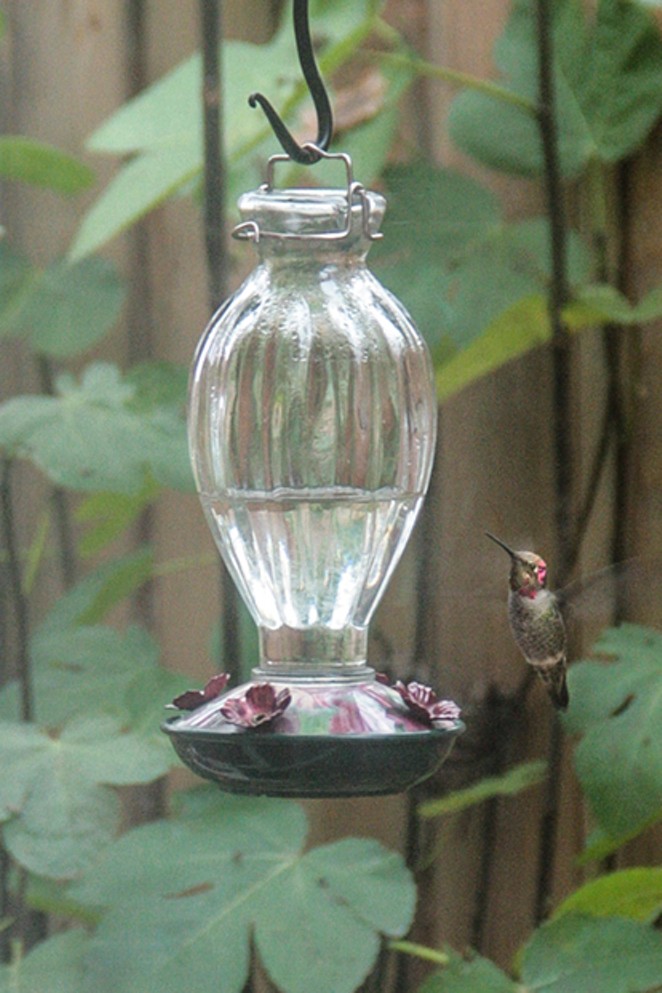The topic of a lot of my phone calls, emails and text messages this fall has been about hummingbirds and feeders in winter, and to be perfectly frank about it, it's a worrisome conundrum.
Right off the bat, sugar water is not the only food for hummingbirds; sure, they get an instant shot of energy from it, but (as far as I know) there's not enough nutrition in it to keep them alive and healthy.
When hummers poke their long beaks into blossoming flowers, there's a lot more going on than guzzling nectar. There are a bunch of tiny arthropods (animals with jointed legs) that are also inside the flowers, containing nectar that hummingbirds eat.
Some are insect larvae, some are millipedes, some are arachnids (spiders and their kin), while some are so small I have no idea what they are. But with or without legs or wings, every one of them supplies what hummingbirds require for sustenance, in addition to nectar. Hummers can locate them in winter but it's no easy task.
Let's face it, hummingbirds can get hooked on feeders, just like humans on whiskey. They see the red on a feeder which attracts them to come look at the device, then they spy the fake flower hole and bingo! — they're into it and hooked. It wouldn't surprise me if researchers also found that hummingbirds—zipping along at 60 mph—can recognize the shape of a feeder from a long distance and will suddenly change course and stop by for a quick pick-me-up.
Please! Do not use that blasted food coloring to make the sugar water red. That stuff can be toxic and unnecessary to make the feeder attractive. Just make up a quart of three parts water and one part sugar and let it go at that.
I know for sure they can see red quickly. Years ago, when my wife Sue and I, along with Rick and Connie Hewitt, were running Ramsey Canyon Preserve—known then as the "Hummingbird Capitol of the World"—in southeast Arizona, I decided to see how well a hummer could see red (not as a saying, but in reality). I cut a dime-sized piece of red tape and placed it on my forehead right between my eyes and hid myself in the underbrush.
I wasn't sitting there for more than 30 seconds when suddenly a big Blue-throated hummingbird was hovering right between my eyes with its beak touching the tape. I was afraid it was going to drill a hole in my forehead!
We don't have Blue-throats in our neck of the woods, but Anna's, Rufous and a few Calliopes are common all through the summer. Many folks in Central Oregon put up feeders for them as soon as flowers begin to bloom in spring.
But what to do about hummers in winter? Here's what I do. Just about the time we have our first really organized frost that leaves ice on the windshield of my trusty old Toyota 4-Runner, I take my feeder in.
As the days continue to get colder I make it a point to watch the spot where the feeder was hanging, looking for any sign of a hummer searching for it. If one turns up I'll put the feeder back into service for as long as the days stay warm. My thinking is the hummer's been here before while migrating south and needs that charge of energy to keep going on. But as soon as the frost nights return I take it back in, wash it out, rinse it well and put it away for the winter.
When I take a trip around Central Oregon, what do I see hanging in plain sight? Yep, hummingbird feeders. I can recall vividly seeing one hanging from the balcony of the Quimby Street Apartments in Bend where my mom lived years back. One day in February, a Rufous was hovering in front of it—at around 20 degrees.
Yes, hummers can go into a "torpor," a state of lowered mental and physical activity. This will increase the bird's tolerance for withstanding the intense cold for as long as 36 hours, maybe to the point of protecting a hummer when the outside temperature goes down to zero. But in Central Oregon and the countryside round about, that low can go on for as long as a week.
In reference to hummingbird winter migration and feeders, the Cornell Lab of Ornithology states:
"A number of factors trigger the urge for birds to migrate, but the most significant one is day length. When the days get shorter, many hummingbirds will move on, regardless of whether there are still filled feeders available for them."
"We do, however, encourage people to keep their hummingbird feeders full for several weeks after they have seen the last hummer, just in case there are stragglers in need of additional energy before they complete their long journey south."
Then there's this from the Seattle Audubon Society:
"There are many documented reports of hummingbirds that survive the snow and freezing temperatures. In fact, Anna's Hummingbirds winter in the state of Washington where they endure cold periods well—as long as they have food sources."
A "cold snap" in Seattle, however, is not like a "cold snap" in Central Oregon, where nights can go down to 10 below zero. I can recall back in 1958 when it went down to 36 below zero at night in Bend, and stayed there for about a week!
So I'll leave it up to you. If you feel leaving your feeder out in winter is doing the right thing for a hummer who didn't get into the migration frame of mind, then so be it. But please take it in at night to keep it from freezing. Who knows, with climate change upon us, maybe a Mexican long-tongued bat may wander through and stop by your feeder for a shot of energy as well...
...And before we part company, you might want to join Cornell Laboratory of Ornithology's program; "Feeder Watch." You can become a Citizen Scientist who will be helping our nation's wildlife and giving a lot of new meaning to your love of birds.
You're welcome to email me with your winter hummingbird story in your yard: [email protected]. Many thanks, Good People.























